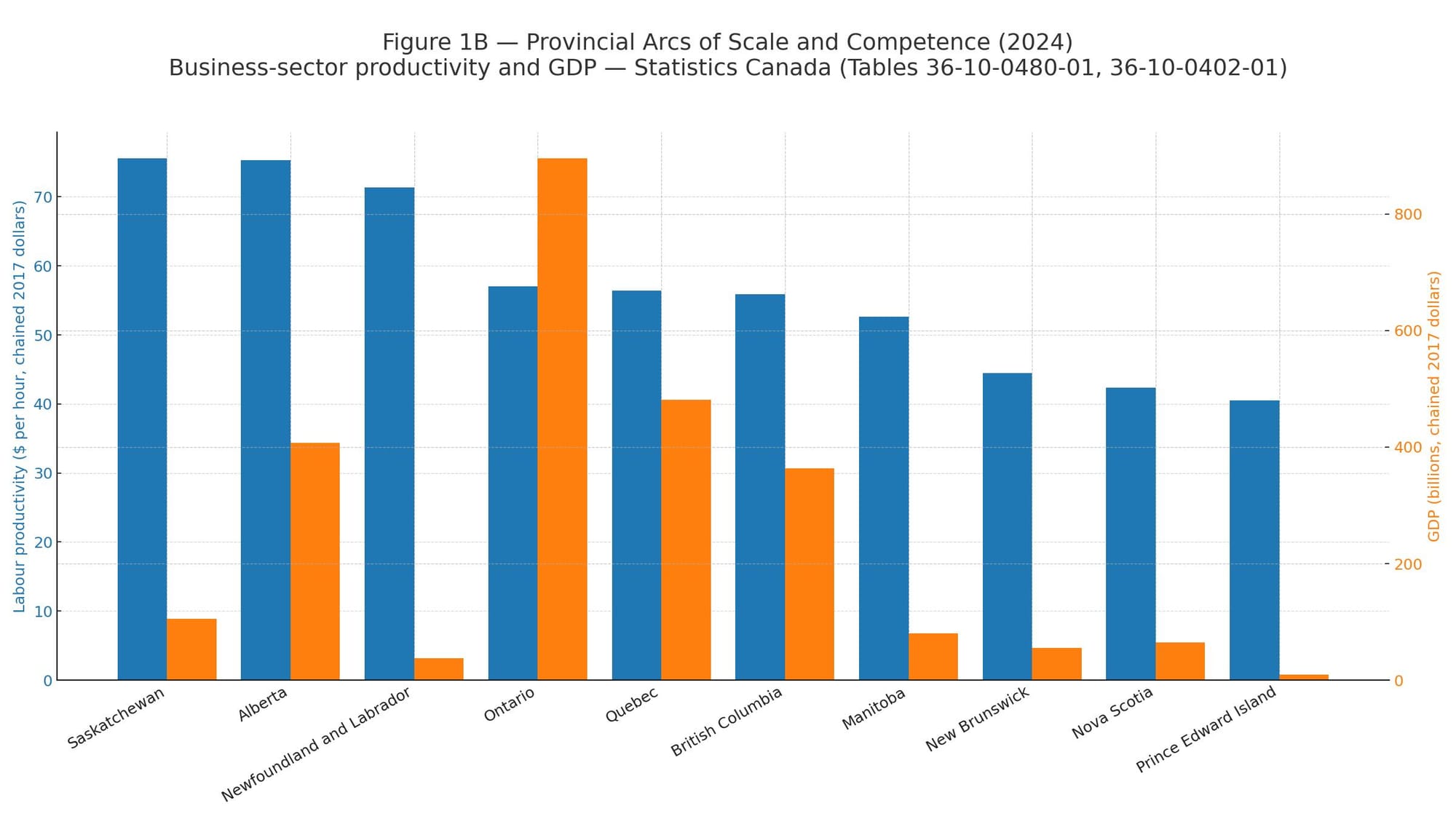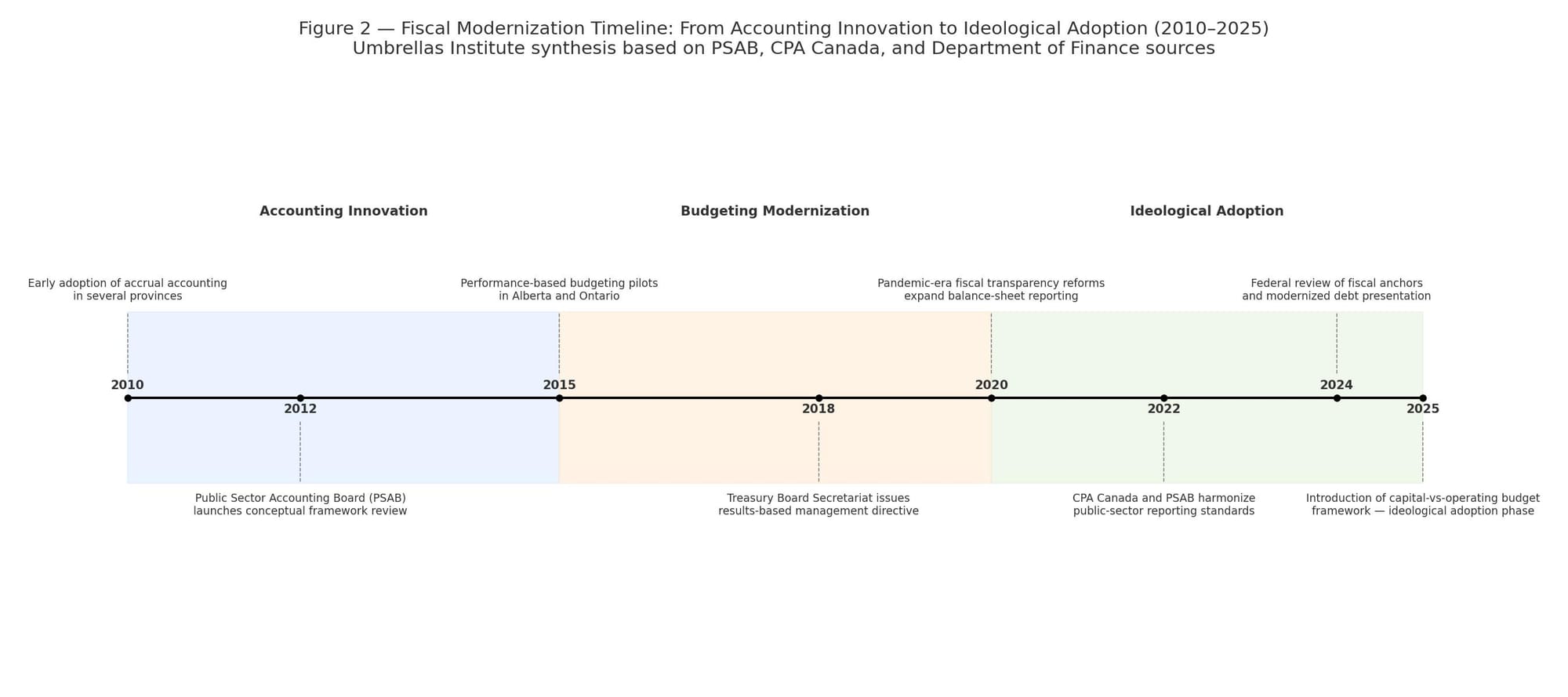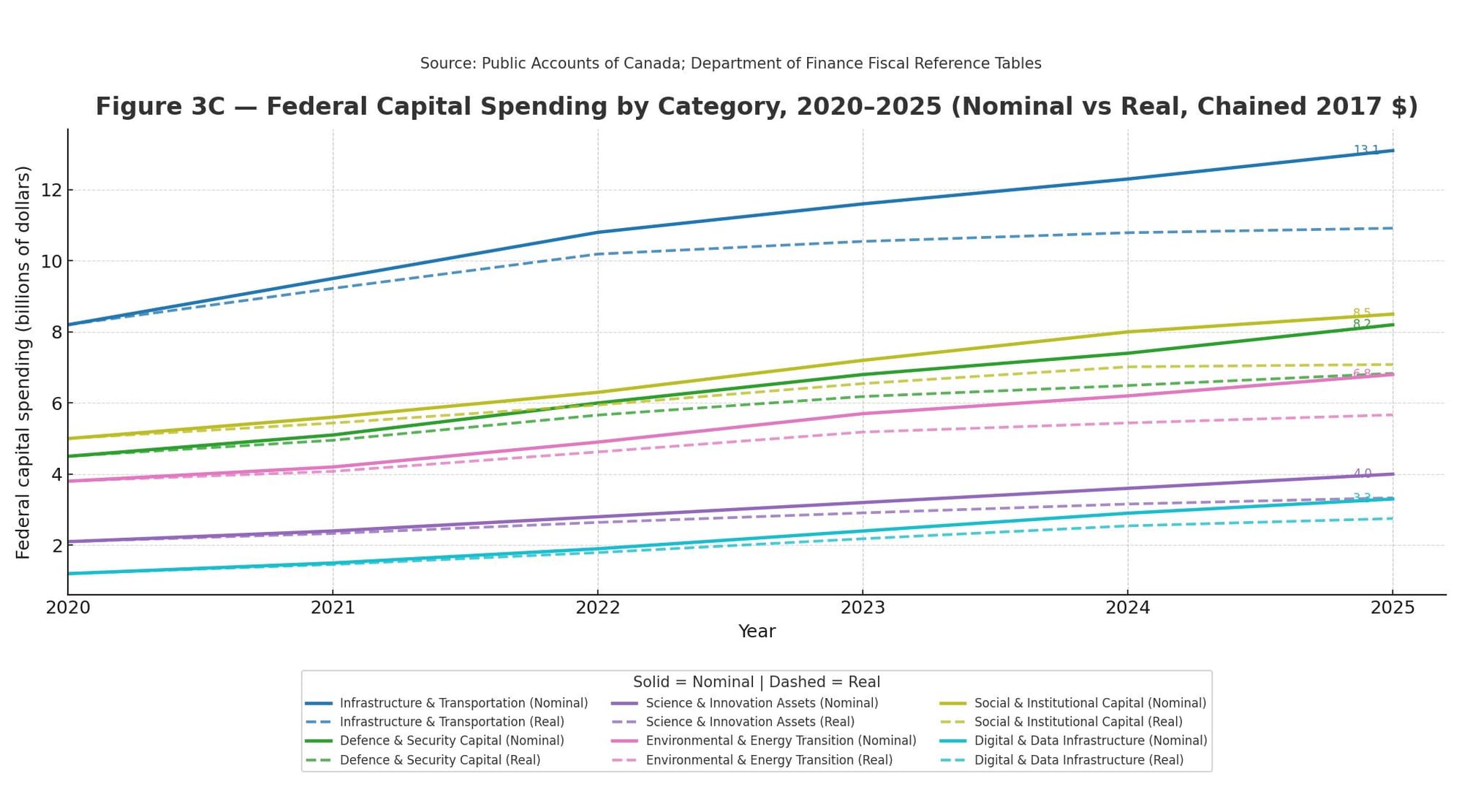Hero
Understanding the architecture of belief, productivity, and power.
Umbrellas Institute examines how advanced economies maintain legitimacy once growth slows and complexity compounds.
Our analysis of the Canadian system views the federation not as a single market but as an evolving mosaic of regional cycles, each shaped by its geography, fiscal stance, and capacity to convert confidence into productivity. What emerges is a portrait of a nation suspended between abundance and fatigue: wealthy in assets, cautious in imagination, and quietly negotiating the limits of its own model.
I. Fiscal Modernization & the Technocratic State
1. The Era of Governance by Framework
At moments of structural uncertainty, nations reach instinctively for new fiscal architectures. Canada’s 2025 reform dividing the federal budget into a balanced operating account and an expansive capital account represents more than bookkeeping. It is the most visible expression of a system seeking order through design: a bet that precision can restore trust.
Across the advanced world, such frameworks have become the grammar of policy credibility. They promise discipline without austerity, flexibility without recklessness. In practice, they encode a deeper transformation: the migration of authority from political negotiation to procedural management.
Where earlier eras relied on ideology, the modern system state relies on syntax: ratios, anchors, and fiscal “rules.” These constructs serve two audiences simultaneously. Domestically, they reassure citizens that prudence endures. Internationally, they signal to capital markets that governance is predictable even when growth is not.


This is the technocratic bargain: transparency as legitimacy, data as virtue.
2. Origins of a New Orthodoxy
The 2025 reform arrived in a world still adjusting to the post-pandemic credit surge and the geopolitical re-pricing of risk. Inflation, once dormant, had returned as a test of competence. Public debt ratios climbed, yet sovereign yields remained mercifully low, a paradox sustained by trust rather than fundamentals.
Within that context, the Department of Finance sought a narrative that could reconcile two truths: Canadians demanded visible investment in housing, climate adaptation, and productivity; investors demanded visible restraint. The solution was architectural rather than ideological, to separate what government spends to live from what it spends to grow.
By formalizing that divide, Ottawa joined a lineage stretching from Germany’s post-war “golden rule” to the fiscal compacts of the Eurozone. The model treats the state like a corporation with two ledgers: one for operations, one for capital formation. The intent is coherent; the risk is semantic drift.
When every spending item that might eventually enhance capacity can be labeled “investment,” the distinction between prudence and indulgence blurs. History shows that such flexibility expands asymmetrically, never toward restraint.
3. Rules as Instruments of Narrative
The Canadian variant of the new orthodoxy carries its own linguistic fingerprints: fiscal anchor, credible path, inter-generational equity. These phrases operate as moral technologies, they transform accounting choices into ethical commitments.
In public communication, the emphasis on “capital” evokes construction, innovation, and legacy. Yet the reform’s breadth allows transfers, tax expenditures, and housing subsidies to occupy the same category as infrastructure and research. In effect, the state reclassifies not only its finances but its story.
The short-term reward is psychological: deficit headlines shrink, investor confidence stabilizes, and ministers can claim both discipline and ambition. The long-term cost is cognitive: the nation begins to measure virtue by category rather than by outcome.
As the national accounts become narrative accounts, credibility risks detaching from performance.

4. Institutional Consequences
Behind the symbolism lies a quiet redistribution of power.
- From Parliament to Process: Once spending qualifies as “capital,” oversight migrates from political scrutiny to technical certification. Committees debate less, auditors verify more.
- From Fiscal Policy to Communications Policy: The credibility of the framework depends less on balance sheets than on how convincingly officials articulate them.
- From Macro Management to Reputational Management: The success of the model is judged not by its real multipliers but by its perceived prudence.
This shift transforms the finance ministry into an institution of narrative engineering. Staff must not only model outcomes but model belief. The federal budget becomes an annual confidence report, each line item a sentence in a larger story about self-control.
Such transformations are not uniquely Canadian. They echo through nearly every advanced democracy navigating post-growth conditions. The form varies across fiscal councils in Europe, congressional scorekeepers in the United States, and independent budget offices in the Commonwealth, but the logic is identical: when policy cannot deliver abundance, it must deliver reassurance.
5. The Psychology of Anchors
Economic anchors serve as collective promises. They define what the public may expect and what government forbids itself from doing. In practice, their power lies not in enforcement but in belief.
Canada’s new anchor, the commitment to balance the operating budget within three years, functions as a symbolic horizon. It invites trust in a process that no one outside the institution can fully verify. If the target is met, confidence appears earned; if deferred, the deferral itself is rationalized as prudence.
Anchors thus evolve into narrative thermostats: they regulate sentiment more than spending. They cool anxiety when markets overheat and warm expectations when confidence chills.
Every thermostat relies on feedback. Without independent measurement of investment quality, the true return on public capital, the system risks mistaking motion for correction.
6. Investment Quality and the Return Illusion
The central unresolved question in Canada’s modernization is definitional: what counts as a productive asset?
Infrastructure spending yields tangible multipliers: logistics capacity, housing supply, resilience. Yet a growing share of the “capital” envelope now consists of tax credits, subsidies, and financial guarantees whose productivity effects are diffuse or deferred. The reform’s success therefore depends on the creation of a national ROI architecture, an independent mechanism to evaluate returns not in political cycles but in generational terms.
Absent that, the risk is structural: the return illusion. Investment appears ample, yet the capital stock, physical and human, stagnates. Productivity growth remains flat, debt service rises, and the illusion of prudence conceals the depletion of fiscal bandwidth.
In macro terms, the nation trades liquidity for leverage, credibility for time.

7. Federalism and Fragmentation
Canada’s constitutional architecture amplifies the complexity. Most infrastructure delivery and social investment occur through provinces and municipalities, each with distinct balance sheets, political calendars, and credit ratings.
The capital-budget reform, though federal in design, depends on provincial cooperation for execution. The result is a multi-layered fiscal ecosystem where Ottawa defines the rule, but provinces determine the multiplier. Coordination failures manifest not as crisis but as drift: projects delayed, cost escalations normalized, accountability diffused.
In the western provinces, fiscal autonomy often translates into skepticism toward national frameworks. In the Atlantic region, dependency on federal transfers limits flexibility. Québec guards its sovereignty by adapting federal programs to its own model of state capitalism. The North remains structurally under-invested, its logistical costs magnifying every inefficiency.
This fragmentation is not a flaw; it is the system itself. The Canadian federation converts diversity into resilience and inertia. The modernization project must therefore function as both policy and diplomacy: a permanent negotiation between tiers of government whose cycles seldom align.
8. Global Pressures and External Validation
No fiscal reform exists in isolation. Canada’s credibility is ultimately priced by international investors who benchmark its trajectory against peer economies.
The shift toward capital budgeting mirrors a broader pattern among advanced states confronting aging populations, decarbonization imperatives, and geopolitical fragmentation. Each seeks to reconcile investment needs with debt constraints. The shared solution is linguistic: to distinguish borrowing for tomorrow from borrowing for today.
As global capital searches for safe yield, frameworks themselves become collateral. A nation’s creditworthiness depends as much on its procedural narrative as on its output gap. This dynamic rewards design sophistication and penalizes political volatility.
Canada’s advantage lies in its institutional continuity: predictable governance, transparent data, moderate polarization. Yet this stability can breed complacency. If the framework becomes self-referential, valued for its existence rather than its efficacy, credibility ossifies into ritual.
9. Historical Perspective: Cycles of Order and Reaction
Each generation of fiscal innovation arises from the exhaustion of the previous one.
- Post-war expansion (1945–1975): Faith in the state’s capacity to plan and deliver prosperity.
- Market correction (1980–2000): Faith in deregulation and debt discipline.
- Technocratic synthesis (2000–present): Faith in calibrated governance — a belief that precise rules can reconcile competing truths.
Canada’s modernization belongs to the third phase. It assumes that legitimacy can be engineered through design; that if metrics are clear, politics will behave. The paradox is that politics eventually re-enters through the back door: definitions contested, thresholds renegotiated, exceptions codified.
In this sense, the 2025 reform is less a break than a continuation — the next chapter in a century-long oscillation between freedom and control.
10. The Moral Dimension of Competence
Public finance has always carried a moral undertone: the notion that prudence is virtue and deficit is vice. The modernization project re-frames that morality as technique. Competence replaces restraint as the measure of righteousness.
This subtle shift matters. A balanced operating budget no longer signals thrift but sophistication; debt for investment becomes not a failure of discipline but a proof of ambition. The vocabulary of virtue thus evolves with the system it describes.
Yet citizens do not feel competence, they feel consequence. When real wages stagnate and housing absorbs their disposable income, procedural mastery offers little comfort. Fiscal credibility divorced from lived experience risks becoming what one analyst once called “the politics of polite decline.”
11. Feedback Loops and Credibility Risk
Every confidence system contains its own mechanism of exhaustion. In the early years, transparency breeds trust; in maturity, metrics multiply faster than meaning. Stakeholders learn to game indicators, and reformers respond with new indicators. The loop tightens until measurement supplants management.
The Canadian fiscal architecture is approaching that inflection point. Its next evolution will depend on whether institutions can pivot from signaling to substance, from the optics of prudence to demonstrable productivity gains.
The stakes are high. In a low-growth, high-debt world, the difference between credibility and complacency is not philosophical; it is fiscal.
12. Looking Ahead
The modernization framework may yet achieve its promise if it meets three conditions:
- Transparent Taxonomy: A clear, enforceable definition of capital spending grounded in measurable productivity impact.
- Independent Evaluation: An ROI authority empowered to audit the real returns of public investment, insulated from political cycles.
- Public Literacy: A citizenry capable of interpreting fiscal data without mediation, sustaining accountability through comprehension.
If these are realized, Canada could pioneer a model of adaptive governance, one that acknowledges structural limits while still enabling long-horizon ambition. If not, the country risks repeating the pattern of late-cycle democracies: abundant frameworks, diminishing trust.

Transition to Section II
The fiscal story is only the surface of a deeper structural equation. Beneath the architecture of budgets lies the machinery of productivity, the nation’s capacity to transform capital into output and optimism into growth.
The next section traces that machinery: how Canada’s real economy has drifted from its promise, why innovation has failed to scale, and how the provinces mirror different stages of the same national cycle.


